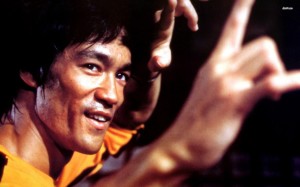 Jackie Chan, Jet Li, Tony Jaa, along with every new up and coming martial arts star has been referred to as “The next Bruce Lee.” Lee practiced martial arts, taught others, brought martial arts to the mainstream via television and movies while breaking racial stereotypes in Hollywood. Now, some 40 years after his death,
Jackie Chan, Jet Li, Tony Jaa, along with every new up and coming martial arts star has been referred to as “The next Bruce Lee.” Lee practiced martial arts, taught others, brought martial arts to the mainstream via television and movies while breaking racial stereotypes in Hollywood. Now, some 40 years after his death,
Bruce Lee is still the unreachable standard, the very definition of what it means to be the representation of a martial arts expert. This year, on what would have been Lee’s 75th birthday which is being celebrated, in part, by Robert Rodriguez’ El Rey channel as part of their Thanksgiving “Way of the Turkey” marathon (check with your television provider for listings). In honor of birthday, let’s delve into this man who has set the bar so high for all who would dare to come after him.
Lee, born in San Francisco but raised in Hong Kong, began studying a form of martial arts called Wing Chun when he was 16. However, Lee’s fighting ability got him into trouble with organized crime when he beat the son of a triad family. For his protection, Lee was sent to San Francisco to live with his sister. A few months later, Lee moved to Seattle where he completed high school and began college.
In Seattle, Lee opened his first martial arts school Jun Fan Gung Fu (Bruce Lee’s Kung Fu). With the help of martial arts practitioner James Yimm Lee, he opened a second school. It was through James Yimm Lee that Lee would meet Ed Parker, American martial artist and organizer of the Long Beach International Karate Championships. It was from this performance that Lee eventually landed his role in the television series The Green Hornet.
Lee’s father, Lee Hoi Chue, was a Cantonese opera and film actor and because of this affiliation, Bruce had appeared in almost 20 Chinese films. He largely abandoned his acting career when he moved to the United States, choosing to focus on his Kung Fu. However, the premier of The Green Hornet began Lee’s path to a very unique stardom. Soon, Lee was very much in demand, but still focused on Jeet Kune Do to supplement his meager film income.
Jeet Kune Do (JKD) was Lee’s personal style of martial arts. This style of martial arts stemmed from Lee’s attempt to quiet his own mind when he felt himself becoming tense and angry during sparring sessions. JKD was explained by Lee to be “a style without style,” encouraging each practitioner to be fluid, allowing combat to be spontaneous.
Lee may have continued his martial arts training, with film on the side, if it wasn’t for an injury to his fourth sacral nerve in 1970. He attempted a 125 lb barbell lift that he did frequently, only this time, it landed him in bed for six months. The prognosis: Bruce would never do Kung Fu again.
While Lee was recuperating from his injury, he again attempted to break into stardom in Hollywood, with little success. However, during a visit in Hong Kong, Lee found that the Chinese filmmakers remembered him from his childhood acting days and had been following his American film career. It was with Chinese film company Golden Harvest that Lee made The Big Boss. The film, about a man named Cheng who works in an ice factory that is actually a front for drug smuggling, made Lee a star across Asia.
The Big Boss and its follow up, Fists of Fury made Lee a marketable commodity. He continued this success with another record breaking movie, The Way of the Dragon, a martial arts action comedy in which a man must help his relatives at their restaurant in Italy and defend against brutal gangsters who have been harassing them. Enter The Dragon followed in 1972 and Lee was once again working with Hollywood. The plot followed a martial artist, Lee, who used his participation in a martial arts tournament to spy on a reclusive crime lord.
Unfortunately, Lee would not live to see the release of his final movie. He passed away on July 20, 1973 due to a drug sensitivity to an otherwise benign painkiller. Lee’s reputation would continue to live in posterity and throughout the 1970’s, martial arts became increasingly popular, both in the movies and in practice. Lee is also credited with breaking through the stereotype of the Asian Villain; a cartoony Fu Man Chu was replaced with a strong and viral Asian fighter.
Bruce Lee was a record breaker, personally and professionally determined and disciplined. It is for that reason that in 32 short years, he was able to make himself an icon, as popular 40 years after his death as he was in his prime. Though many have tried to imitate his skills and career, Lee still sets a very high standard for all who choose to follow his example.